Key takeaways:
- Proper ebook formatting enhances reader experience and ensures content accessibility across different devices.
- Tools like Scrivener, Adobe InDesign, and Vellum can significantly simplify the formatting process.
- Consistency in design, spacing, and testing on multiple devices are crucial best practices for effective ebook formatting.
- Inclusivity and simplicity in design choices are essential to avoid alienating readers and maintain focus on the content.
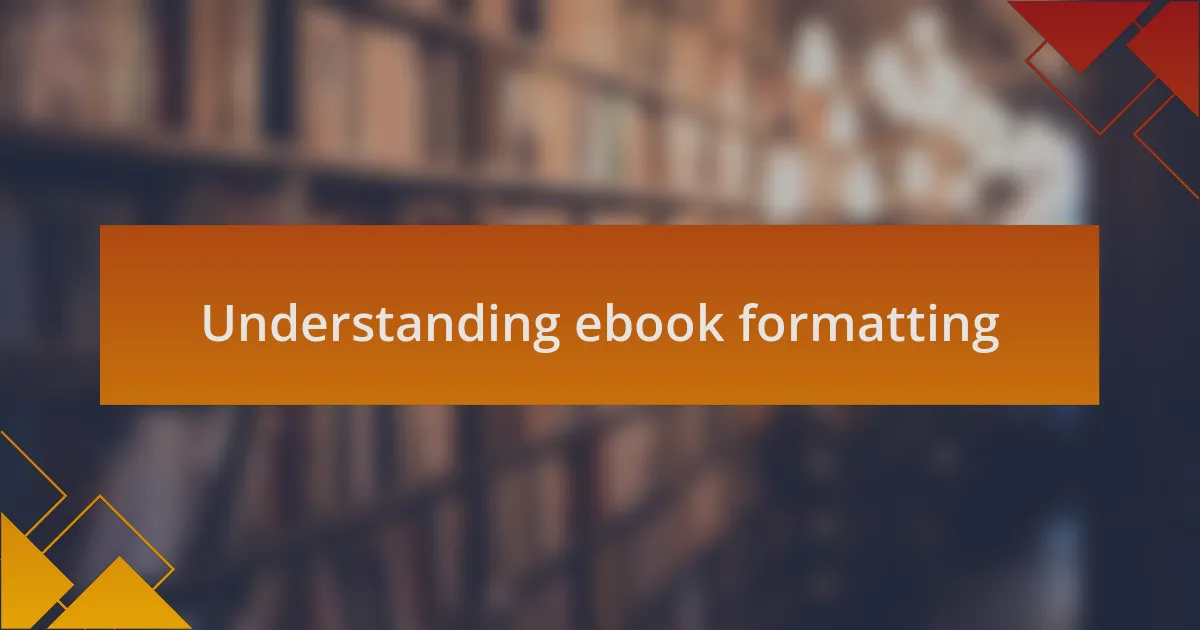
Understanding ebook formatting
When I first delved into ebook formatting, I was overwhelmed by the myriad of options available. It felt like learning a new language with all the technical terminology floating around. But, as I navigated the process, I realized that mastering formatting was crucial for enhancing reader experience. After all, isn’t that what we ultimately want?
Understanding the differences between formats like EPUB and MOBI made a significant difference for me. EPUB is great for reflowable text, allowing readers to adjust font sizes easily, which I appreciated as someone who prefers adjusting my settings. On the other hand, MOBI well suited Kindle devices, but I remember struggling at first to get my content to display correctly. Have you ever faced the frustration of viewing your hard work crumble in a different format?
The process taught me the importance of consistency – from font choices to chapter headings. I recall spending hours meticulously aligning elements only to realize later that a clean, simple design could be just as impactful. It’s a bit like fashion; sometimes, less is more. Ultimately, effective ebook formatting helps convey the story without distractions, allowing the reader to lose themselves in the narrative as I often do.
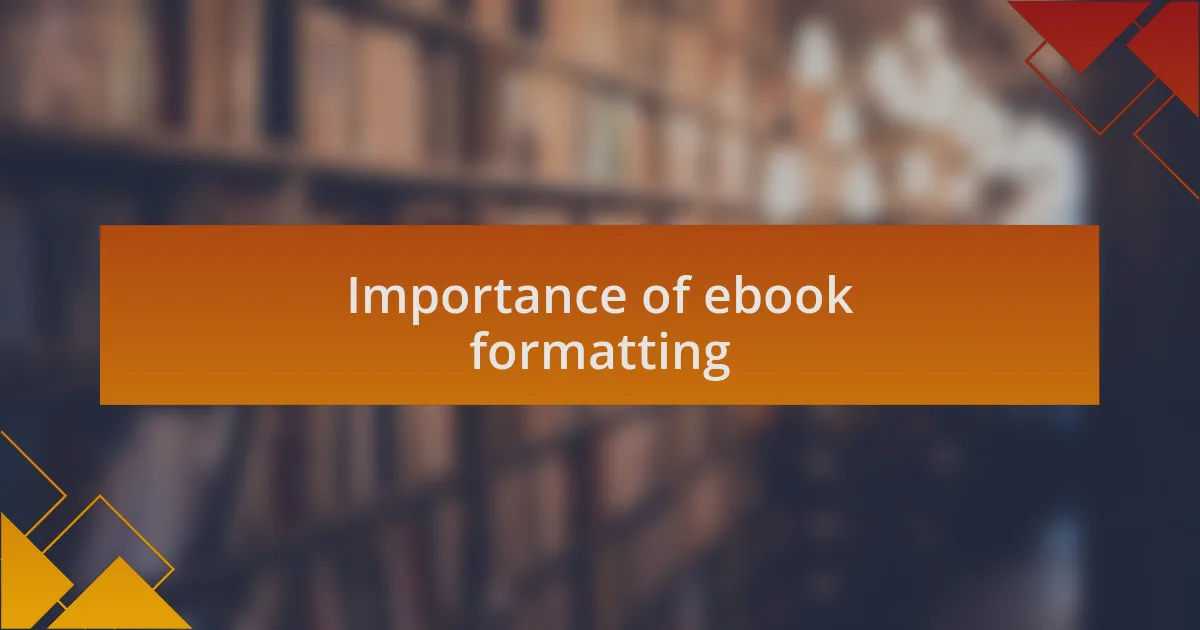
Importance of ebook formatting
When I think about the importance of ebook formatting, I can’t help but remember the first time I published an ebook. I felt a mix of excitement and anxiety, realizing that proper formatting was the key to ensuring my words resonated with readers rather than becoming a source of frustration. Have you ever put your heart into a piece of writing, only to see it marred by awkward line breaks and unreadable text? It’s disheartening and completely avoidable with thoughtful formatting.
The way an ebook is formatted can dramatically influence its accessibility. I learned that ensuring a smooth reading experience not only helps retain readers but also creates a professional appearance that boosts credibility. I once downloaded a poorly formatted ebook, and I found myself constantly struggling to navigate it. It made me question whether the content was worth my time, reinforcing the idea that presentation truly matters, don’t you think?
There’s an emotional connection between the reader and the text that can be shattered by poor formatting. For instance, when I browse through an ebook that flows seamlessly, I often find myself completely immersed in the story. On the flip side, encountering misaligned text or confusing layouts pulls me right out of that experience. It’s a reminder that formatting isn’t just about aesthetics; it’s about respect for the reader’s journey through the narrative.
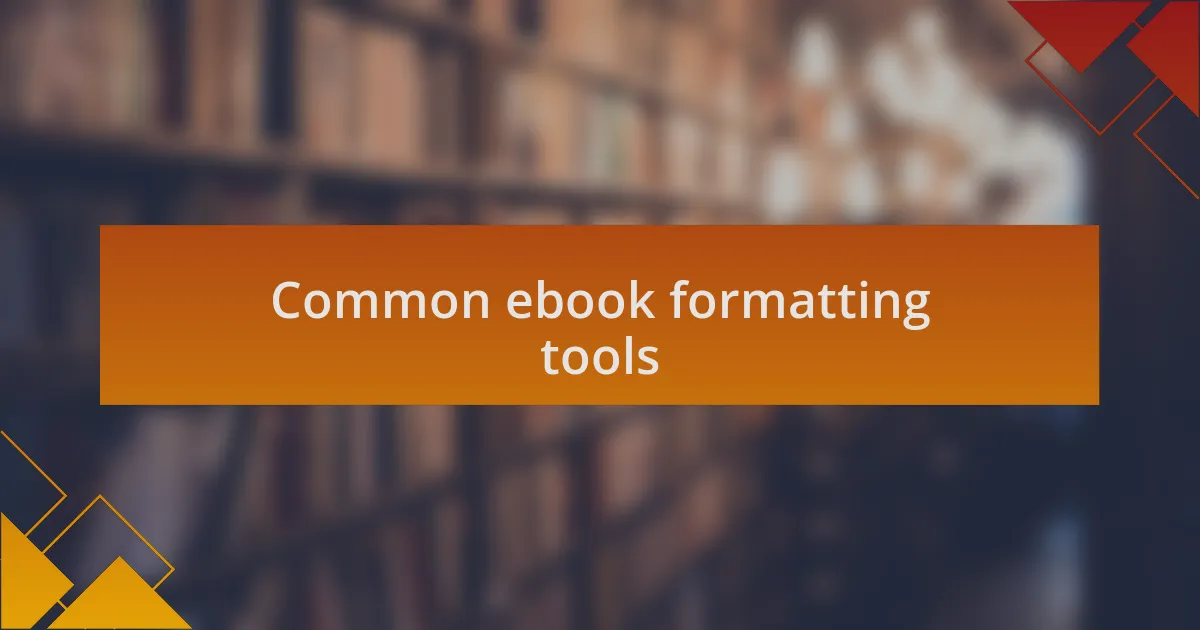
Common ebook formatting tools
When I first dove into ebook formatting, I found myself overwhelmed by the variety of tools available. Among the most popular ones are Scrivener and Calibre. Scrivener was a game-changer for me, allowing for seamless organization of my writing while also offering flexible options for export formats. It’s amazing how a tool can simplify the often daunting task of formatting, don’t you think?
Another option I frequently recommend is Adobe InDesign. I remember the moment I discovered it; the control it offers over design elements made my projects feel more polished. I was able to manipulate everything from typography to layout, creating an ebook that truly reflected my vision. While the learning curve can be steep, the payoff in quality is undeniable.
Recently, I’ve also started using Vellum for my formatting needs. This tool streamlines the process for Mac users, making it easy to create stunning ebooks in just a few clicks. I recall the satisfaction of exporting a beautifully formatted file that I was proud to share. Have you ever experienced that sense of accomplishment in your projects? It’s that feeling that makes all the effort worthwhile.
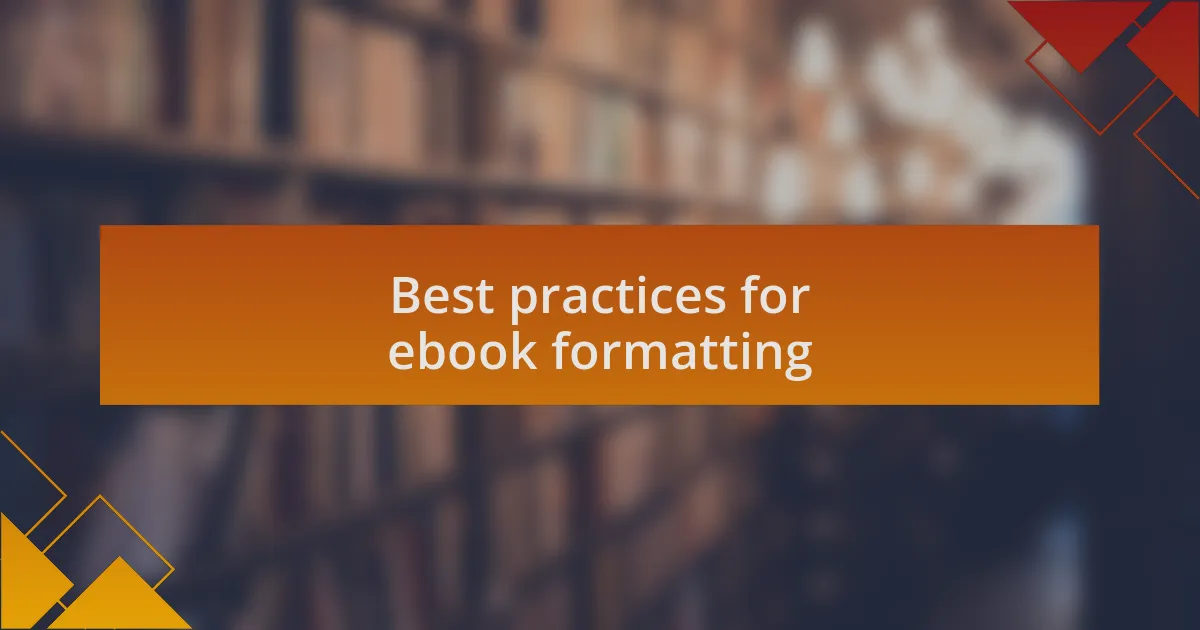
Best practices for ebook formatting
When I first started formatting my ebooks, I quickly realized that consistency is key. Ensuring that the font, heading styles, and spacing are uniform throughout the document not only enhances readability but also gives it a professional touch. I can still remember the time I overlooked this detail and received feedback about my ebook’s uneven formatting—it was a wake-up call that taught me to pay close attention.
Another best practice I’ve adopted is to always preview my ebook on multiple devices before finalizing it. I learned this lesson the hard way when my carefully crafted layout fell apart on a smartphone. It made me acutely aware of the importance of testing formats like ePub and MOBI. By checking how my ebook appears on different screens, I can ensure that every reader enjoys a seamless experience, regardless of their device.
Lastly, I’ve found that incorporating interactive elements, like hyperlinks and bookmarks, can significantly elevate the reader’s experience. Initially, I thought it was unnecessary, but after adding these features, I noticed that readers engaged more with my content. Have you ever clicked a link in an ebook and felt that rush of curiosity bubbling up? It’s those little enhancements that can make your ebook not just informative but also more enjoyable to read.

Challenges in ebook formatting
When it comes to ebook formatting, one of the biggest challenges I faced was mastering the intricacies of different file types. Initially, I thought converting a Word document to ePub or MOBI would be a breeze. However, I learned that each format has its quirks; for instance, images that looked perfect in one version could misalign or distort in another. Have you ever poured hours into perfecting a manuscript, only to see it fall apart when converted? That experience was disheartening and taught me to meticulously adjust and test.
Another challenge I encountered was maintaining accessibility for all readers. I remember publishing an ebook that I thought was visually appealing, only to receive feedback from a friend who struggles with visual impairments. It hit me hard when I discovered my choice of colors and fonts hindered their reading experience. Inclusivity isn’t just a checkbox; it’s a vital aspect of formatting that requires thought and care. How many potential readers are we excluding with our formatting choices?
Lastly, I often grapple with the temptation to overcomplicate the design. Early on, I was convinced that adding ornate designs and fancy fonts would make my ebook stand out. However, I quickly realized that simplicity often reigns supreme in readability. Have you ever stared at overly intricate layouts and felt overwhelmed? I started to appreciate the beauty of clean, straightforward formatting, which keeps the focus on the content rather than distracting the reader.
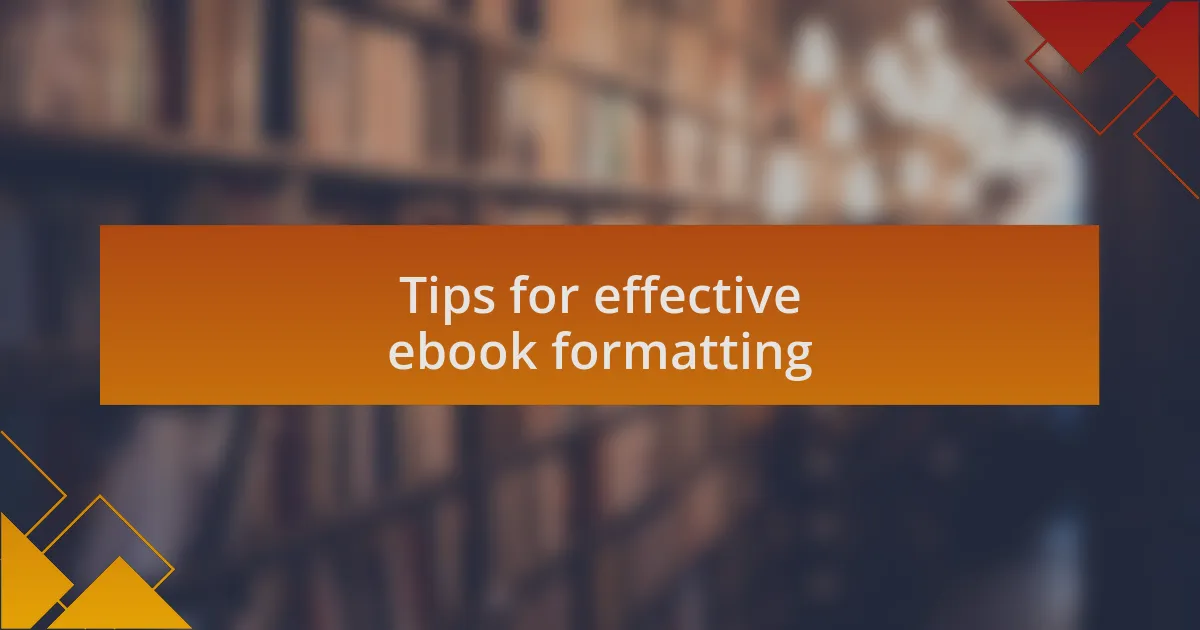
Tips for effective ebook formatting
When it comes to effective ebook formatting, I wholeheartedly believe that consistency is key. I once published an ebook where I varied font sizes and styles for different sections, thinking it would add creativity. Instead, I ended up with a visually jarring experience for my readers. Have you ever tried to read something that felt all over the place? Maintaining a uniform style throughout not only enhances the flow but also makes it easier for readers to absorb the content.
One tip I often share is to utilize proper spacing. In my early projects, I didn’t pay much attention to line spacing and margins, thinking a single format would suffice. However, when I revisited those works, I found my text hard to navigate. I realized that giving the reader room to breathe on the page can significantly improve their experience. That space allows for a natural break, reducing eye strain, and encouraging engagement. How long can you read a cramped page before losing focus?
Lastly, always preview your ebook on multiple devices. I still remember the shock I felt when I viewed one of my early ebooks on a small tablet after perfecting it on my laptop. It looked completely different, and not in a good way. I learned that ensuring compatibility across various devices is crucial—what works on one screen might not translate well to another. Testing isn’t just a formality; it’s an essential step to ensure your readers have a pleasant experience, regardless of how they access your work. After all, don’t we all want our stories to be enjoyed as intended?